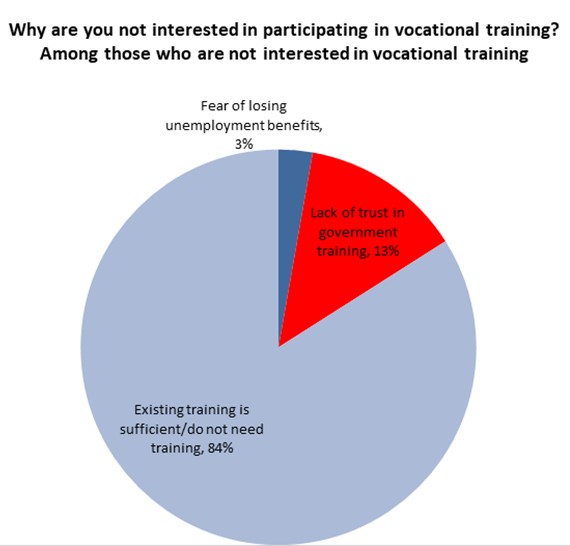Public Attitudes Toward Vocational Training During COVID-19
An IDI survey examines public opinion on Israelis preferred areas of study and participation when undergoing vocational training during the economic crisis resulting from the coronavirus.

In a survey conducted by the Center for Governance and the Economy at the Israel Democracy Institute during the corona crisis, we examined public opinion regarding vocational training in these times. The survey was conducted with the assistance and methodological oversight of IDI’s Guttman Center for Public Opinion and Policy Studies. The Midgam institute was in charge of designing the survey sample.
The survey was conducted in the second week of July, among a representative sample of the labor force, and included 757 respondents that constitute a representative sample of the Israeli labor force.
Main Findings
Interest in Vocational Training: Government-funded short-term vocational programs
Interest in participation: More than half (52%) the respondents indicated they were interested in taking part in government-funded short-term vocational training programs, lasting between 3-6 months. Not surprisingly, the rate is higher (66%) among the “corona-unemployed” (laid off, on forced unpaid leave, and self-employed not working because of the situation).
Salaried employees are more interested in participating in vocational training programs than the self-employed—53% of salaried employees compared to 45% of the self-employed.
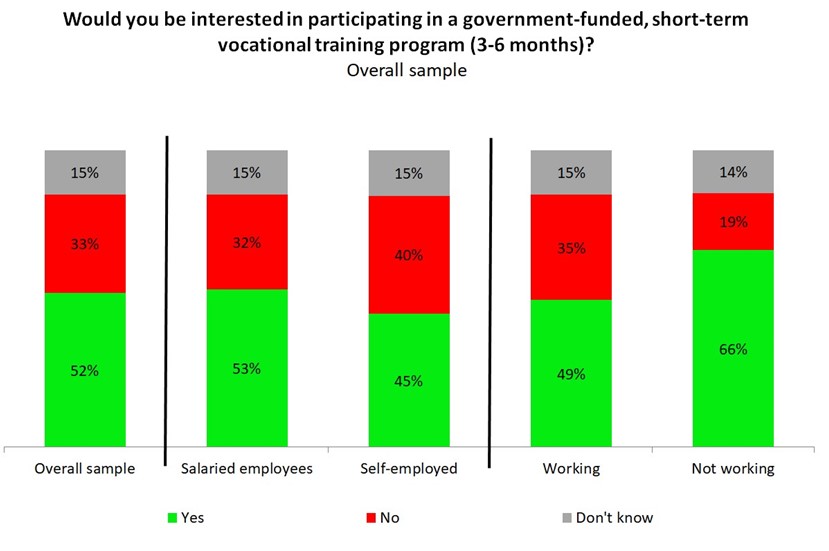
In addition, the rate of those interested in vocational training decreases with the level of education: from 60% among those with relatively low levels of education, to 54% among those with technological education, down to 45% among those with an academic education.
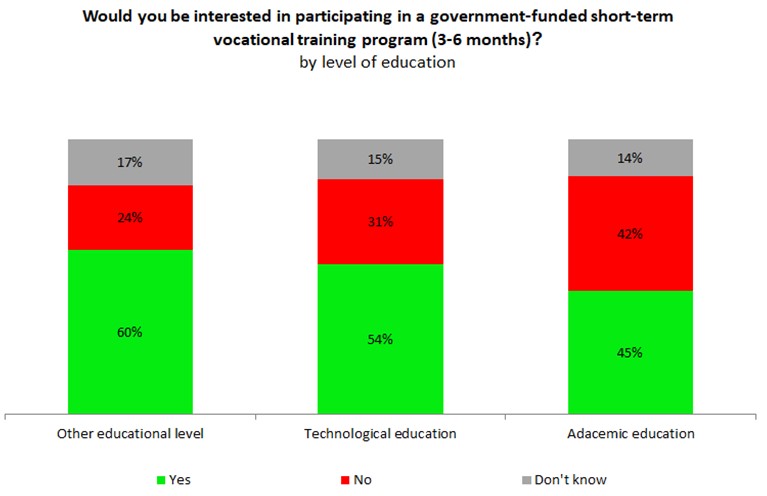
Interest in participation in a vocational training program drops significantly beginning with age 55: Thus, while among those up to the age of 54, the rate of those interested in participating is about 55%, in the 55-64 age group, this drops to 46%, and among those age 65 and over, it drops further to 27%.
It is likely that the decline in the interest in participating in vocational training programs among older adults stems from the fact that older adults perceive their career horizon as too short to make the investment in training worthwhile.

The percentage of high-tech employees interested in participating in vocational training programs was relatively low, compared to employees in other economic branches: 42% and 53%, respectively.
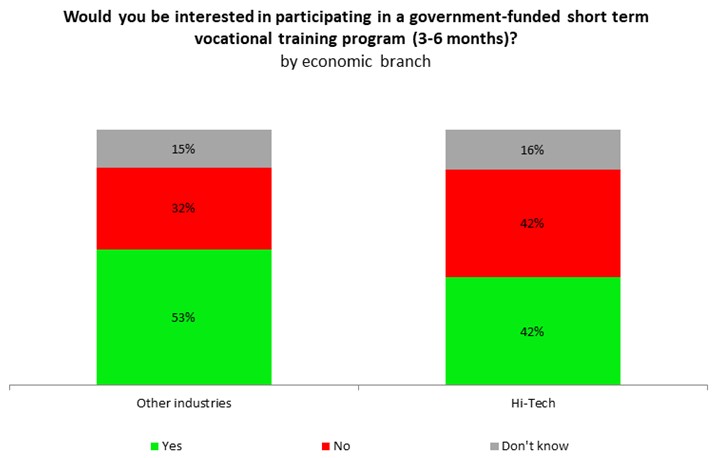
Conditions for Participation in Vocational Training Programs
Of those interested in participating in vocational training programs, 56% indicated that having the option to choose their field of training is a pre-condition for their participation. A similar percentage (54%) stated receipt of living allowances equivalent to unemployment benefits; 48%—the guarantee of a job in the field in which they would be trained; and only 19% stated as a condition the involvement of the employer in their training. Only 6% agreed to participate in such training unconditionally.
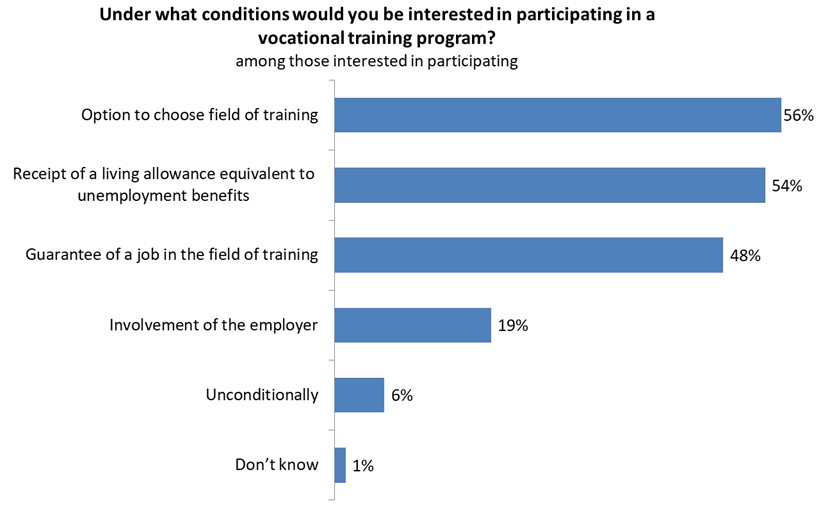
Not surprisingly, the receipt of a living allowance as a condition for participation in vocational training programs is higher (67%) among those not working during this period (laid off, on forced unpaid leave, and self-employed not working due to the crisis), compared to the rate (50%) among those who are still working. This reflects the greater concern among those not working with regard to the loss of entitlement to unemployment benefits during the vocational training period.
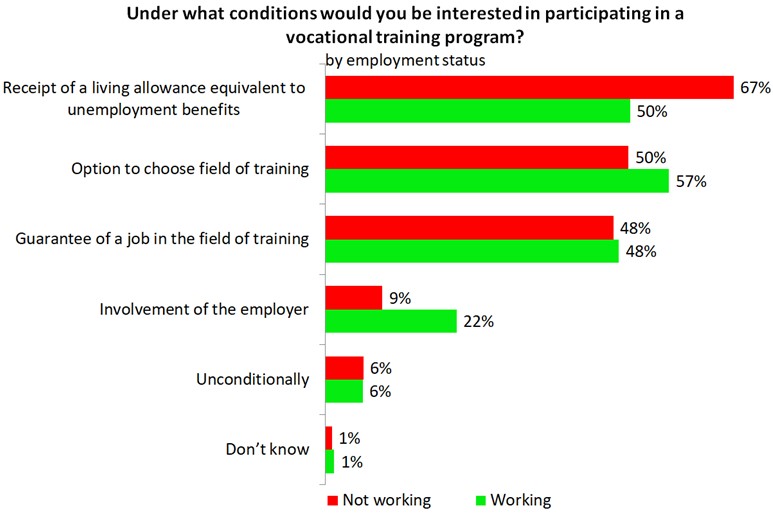
In addition, the percentage citing employers’ involvement as a condition for their participation in vocational training programs was more than double among those who were working (22%) compared with those not working (9%).
Young people, ages 18 to 24, gave highest priority to a guaranteed job in the field (70%) as a condition for their participation, far ahead of other conditions. In second place was the possibility of choosing the field of training (58%) and third receiving living allowances equivalent to unemployment benefits (54%).
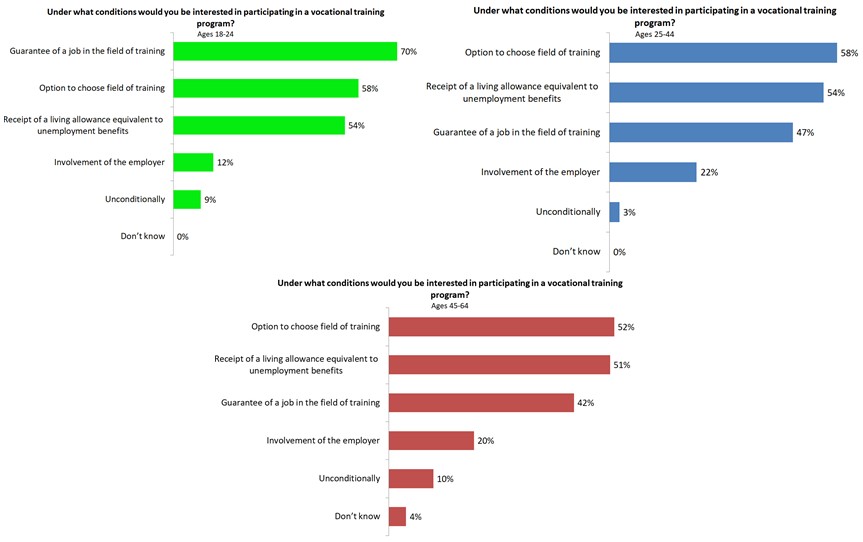
By contrast, older respondents (ages 25-44 and 45-64) rated two other conditions as most important: The possibility of choosing the field of training and receiving living allowances equivalent to unemployment benefits, and only next—guaranteed employment in the field as a condition for participation in training. These gaps indicate differences in the level of concern among different populations with regard to finding a job in the field in which they would be trained, and may indicate different needs in each of the groups.
While among those with academic and technological education, the most frequently cited condition for participation was the possibility of choosing the field of training, and only second—receiving a living allowance, those with relatively low levels of education most often cited a living allowance as the condition for participation. This is consistent with the fact that these are population groups whose economic situation is more challenging, thus making it difficult for them to participate in vocational training programs without receiving a living allowance.
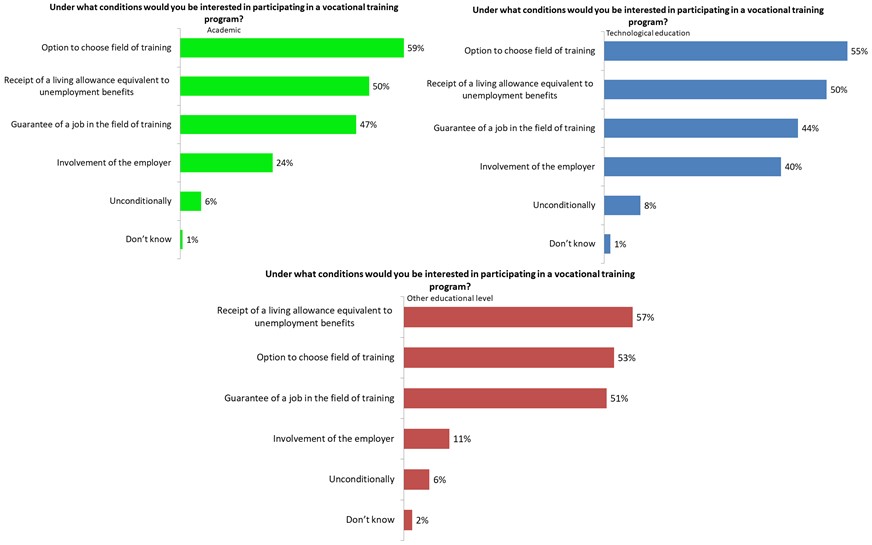
The survey also reveals that hi-tech employees rated the employer's involvement in their training as of higher priority, compared to employees in other economic branches: Among hi-tech employees—29% stated this as a condition, compared to only 18% in other economic branches. By contrast, the guarantee of employment in the field in which training was provided is less important to high-tech employees: 35% among them, and 50% in other economic branches. This difference is not surprising in light of the relatively high demand for high-tech workers, compared to in other sectors of the economy. Without exception, all ranked employer involvement in the areas of training as the lowest priority condition for participation in vocational training.
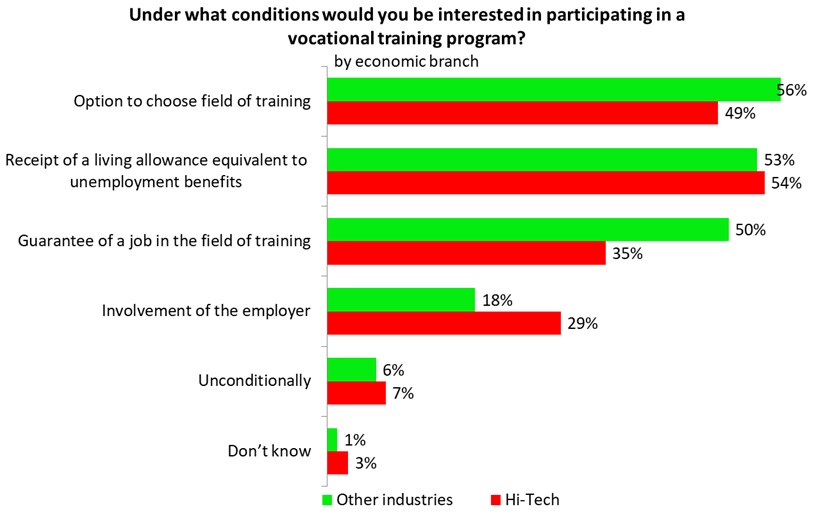
Preferred Areas of Vocational Training
The survey also examined the preferred areas of vocational training, and revealed that the majority of respondents (62%) were interested in training in broad, general areas (such as remote working skills, language skills, teamwork, time management and general management skills) and 56% prefer training in digital skills, including online marketing and sales skills. About half are interested in training in their current field, and a similar percent are interested in retraining in another field. By contrast, only 23% are interested in participating in vocational training in a field which their current employer defines as needed, even though participating in such a training program is likely to increase the chances of working in this field (a factor which half the respondents interested in participating in vocational training, defined as important).
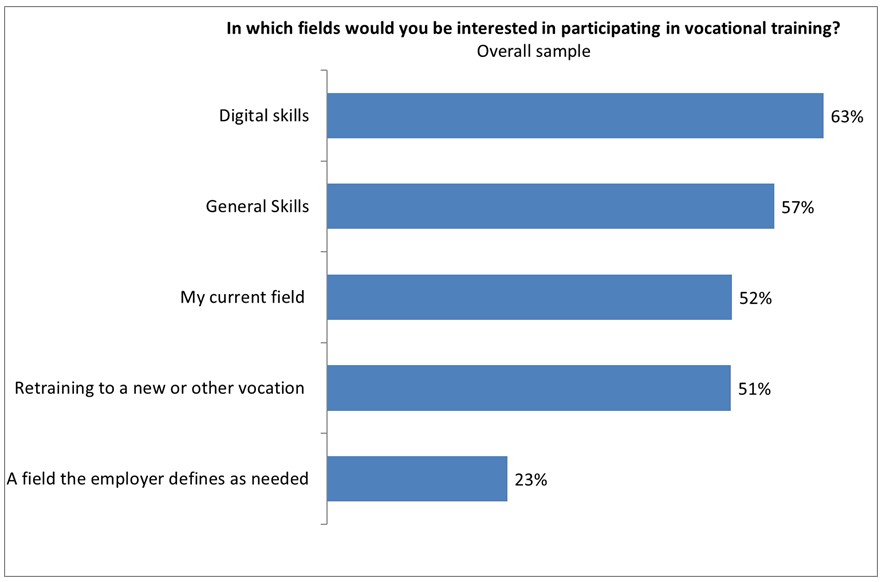
While among younger people, preference for training in general skills ranked highest in priority (85%); and next—digital skills (61%)—(which can also be classified as a type of general skill), those in the 25-44 age group, granted higher priority to training in their current field (63%), and in general skills (60%), followed by—training in the field of digital skills (56%). By contrast, the older population ranked retraining to another / new field (59%) as its top priority; and second—training in digital skills and general skills (55% for each).
At all ages, the option of training in the field an employer defines as required, ranked last.
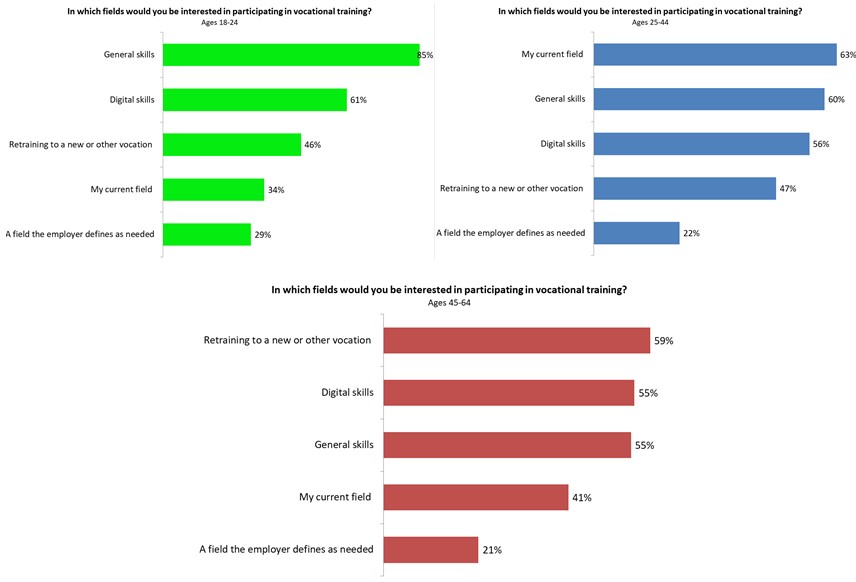
Preferred fields of vocational training also differ by education. While those with an academic education are interested in training in general skills (59%), digital skills (57%) and training in their field (58%) to the same extent, those with a technological education are more interested in retraining in a new / different field (62%), and next—in training in their current field (57%). Training in digital skills also attracted considerable interest among those with a technological education (52%), but general skills received a relatively low preference among them (38%)—unlike among the other groups.
Among those with relatively low education (not academic or technological), training for general skills ranked first in preferences (69%), followed by digital skills training (55%).
Here too, all groups ranked training in areas that an employer defines as required, as lowest in priority.

Analysis by economic branch reveals that the preference for training in general skills is less prominent (51%) among those in the hi-tech industry as compared with those in other economic branches (63%). By contrast, a significant percentage of those in high-tech, are interested in vocational retraining in another / new field: 67%, compared with 49% among those in other economic branches.
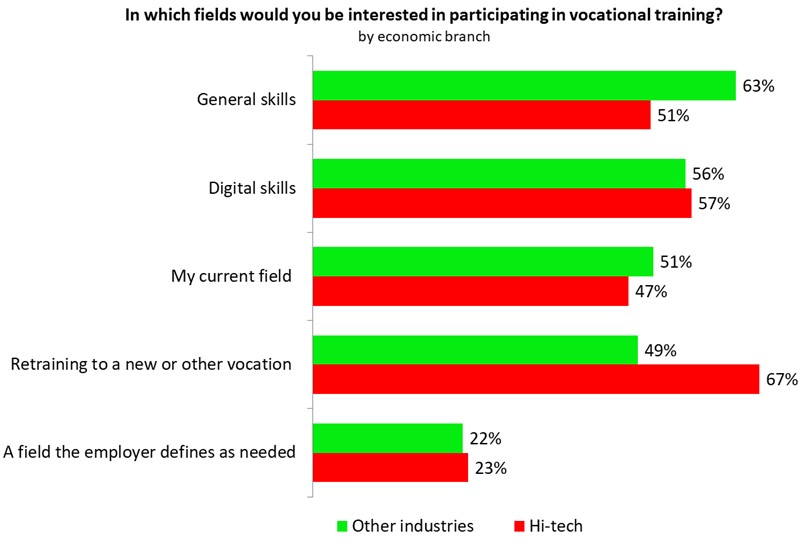
Reluctance to Participate in Vocational Training Programs
Most (84%) of the respondents who were not interested in taking part in government-funded short-term vocational training programs (which comprised 33% of the total sample) stated that this is so because their current training is sufficient, or because they do not need training. An additional 13% cited their lack of trust in government training, and only about 3% cited the fear of losing unemployment benefits as the reason for their lack of interest in vocational training (the latter consists solely of salaried employees, since the self-employed have no unemployment benefits).
Thus, despite the fact Israel’s labor productivity is low as compared to the OECD average, and that the Israeli worker's basic skill set is also low when compared internationally (according to the PIACC survey), most of those who indicated that they were not interested in participating in vocational training programs stated that their training is sufficient or that they do not need training. This implies a need for informing and educating the public as to the importance of vocational training and enrichment, as a means both for raising labor productivity alongside improving wages and enhancing opportunities for advancement.
